 |
 |
 |
| |
Safety and Antiviral Activity of Fosamprenavir (FPV)-Containing Regimens in HIV-Infected 2 to 18 Year Old Pediatric Subjects (Interim Data, Study APV29005)
|
| |
| |
Reported by Jules Levin
CROI, Feb 2007, Los Angeles
Coleen Cunningham*1, Abigail Freedman2, Stanley Read3, Dan Duiculescu4, Eugene Voronin5, Isabel De Jose6, D Perez-Tamarit7, Alicia Carrod8, Jane Yeo8, and Harmony P. Garges9
1Duke University Medical Center, Durham, NC US; 2New York Weill Cornell Medical Center, New York, NY US; 3The Hospital for Sick Children, Toronto, Canada; 4Spitalul Clinic de Boli Infectioase si Tropicale "Victor Babes", Bucharest Romania;
5St. Petersburg Republic Hospital of Infectious Disease, St. Petersburg, Russian Federation; 6Hospital Infantil la Paz, Madrid, Spain; 7Hospital Infantil La Fe, Valencia, Spain; 8GlaxoSmithKline, Greenford, UK; and 9GlaxoSmithKline, Research Triangle Park, NC US
APV29005 was designed to evaluate FPV/RTV BID dosing in HIV-1 infected pediatric subjects ages 2 to 18 years of age who are PI-naive or PI-experienced and FPV BID in PI-naive pediatric subjects 2 to 5 years old.
AUTHOR CONCLUSIONS
FPV and FPV/RTV were generally well tolerated in this pediatric population with a profile consistent with adult experience; no new safety concerns were identified
with either the oral suspension or tablet formulation.
Good antiviral responses were demonstrated particularly when one considers the
prior ART history and baseline resistance profile of the populations.
All data from this study, including PK, safety and antiviral response data are
currently being reviewed by regulatory authorities for assessment of a pediatric
indication.
ABSTRACT
Background: The HIV-1 protease inhibitor (PI) fosamprenavir (FPV), the phosphate-ester prodrug of amprenavir, is being studied in PI-naive and experienced (exp) HIV-1 infected pediatric subjects ages 2-18 years in order to
determine the pharmacokinetics (PK), safety and antiviral activity of FPV alone or with ritonavir (FPV/RTV) BID. PK data will be presented at a later time.
Methods: Prospective, open label, multi-center, 48-week cohort study with interim analysis (cut-off date 22 May 2006). Formal statistical hypothesis testing was not performed in this non-comparative study.
Results: 75 HIV-1 infected subjects were enrolled and received at least one dose of FPV (±RTV). Median exposure to FPV was 52 weeks (range: 2-84 weeks), with 68% exposed >48 weeks. ABC/3TC was the most common initial background ART (used by 47%). Twenty-one subjects were aged 2-5 years, 25 were aged 6-11 years, and 29 were aged 12-18 years. A majority of subjects were female (57%) and white (69%). At baseline, 45/75 were PI-naive and
30/75 were PI-exp. Only PI-naive 2-5 year old subjects received unboosted FPV BID (18/75); all other subjects received FPV/RTV BID (57/75). Median baseline HIV-1 RNA was 5.1 log10 c/mL for the FPV group, and 4.6 log10 c/mL and 4.5 log10 c/mL in the FPV/RTV group, for PI-naive and PI-exp subjects, respectively.
Of the 75 subjects, 12 (16%) discontinued their treatment regimen prematurely, two from the FPV group and 10 from the FPV/RTV group. HIV-1 RNA <400 c/mL among PI-naive subjects at Week 24 was 67% in FPV group and 70% in FPV/RTV group, vs. 57% of PI-exp subjects in the FPV/RTV group (ITT[E], TLOVR). Median increases in CD4+ cell percentages at Week 24 occurred in all groups, and ranged from 4-8%.
Drug-related Grade 2-4 adverse events occurred in 9/75 subjects (12%); the most frequent were diarrhea (2/75, 3%) and vomiting (2/75, 3%). Nine subjects experienced SAEs; including 6 with hypersensitivity to abacavir. The incidence of treatment-emergent Grade 3/4 clinical chemistry and hematology laboratory abnormalities was 6% (1/18) and 0% respectively in the FPV group and 13% (7/55) and 6% (3/54) respectively in the FPV/RTV group.
Conclusions: Following a median duration of 52 weeks exposure FPV and FPV/RTV were generally well tolerated and demonstrated good antiviral activity in both PI-naive and PI-experienced 2-18 year old pediatric subjects.
METHODS
APV29005 is an international, 48-week, Phase II, open-label, multi-cohort, multicenter study conducted in HIV-1 infected, pediatric subjects 2 to 18 years old.
Subjects were given FPV ± RTV as investigational products to be used with a background regimen of two active NRTIs. FPV was administered as either oral 700mg tablets (if a subject weighed ≥39 kg) or 50mg/mL oral suspension.
RTV was given as either 100mg capsules (if a subject weighed ≥33 kg) or as an 80mg/mL oral solution. Dosing was designed to deliver similar plasma APV concentrations as achieved in adults receiving FPV or FPV/RTV BID.
The doses were revised for certain cohorts, based on preliminary PK data, as shown in Table 1.
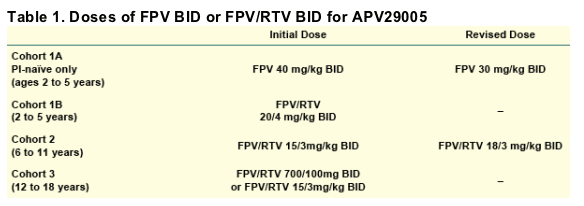
The primary endpoints of the study are plasma APV AUC(0-_), Cmax, and C_ (not presented), the proportion of subjects who permanently discontinue FPV/RTV or FPV due to AEs, and the incidence and nature of AEs and laboratory abnormalities in study subjects. Antiviral response is a secondary endpoint.
As this was a non-comparative study, no formal statistical hypothesis testing was performed in this analysis and no power calculations were performed in order to derive the sample size. Recruitment of 78 subjects was considered an appropriate number to obtain robust information on the safety and tolerability following administration of FPV BID and FPV/RTV BID.
Only descriptive methods were used for the analysis of antiviral activity and safety assessments. Time to loss of virologic response (TLOVR) analysis and 'observed' analysis were used for the summary of proportion endpoints
using viral load data. For the TLOVR analysis, positive responders were those who had a confirmed plasma HIV-1 RNA response <400 or <50copies/mL prior to the visit of interest, but without having experienced treatment failure.
Treatment failure was defined as the first of the following events: confirmed plasma HIV-1 RNA ≥400 or 50copies/mL, permanent discontinuation of study drug or death. Both Intent to Treat Exposed [ITT(E)] and Safety populations
included all subjects with documented evidence of having received at least one dose of investigational treatment.
RESULTS
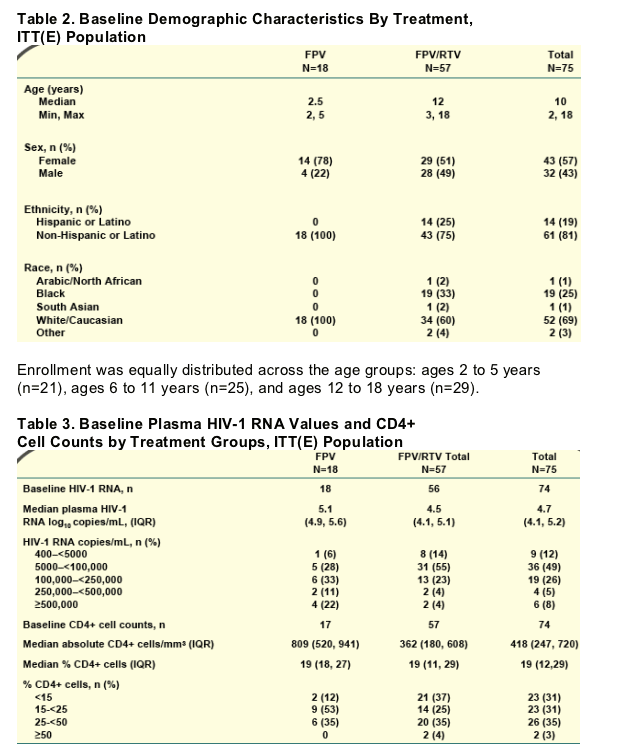
For CDC classification in children <13 years, the majority of the subjects in the FPV group (89%) were classified as 'mildly symptomatic' whereas subjects in the FPV/RTV group were fairly evenly distributed across the three CDC classes. Those subjects >13 years of age were primarily CDC Class A or B.

Sixty-seven percent (50/75) of the subjects in the study were ART-experienced with 60% (30/50) of these subjects being PI-experienced.
Most of the PI-experienced subjects (n=30) had one prior PI exposure (67%), with NFV being the most commonly prescribed PI; the median duration of prior PI exposure was 253 weeks (range 27 to 423 weeks).
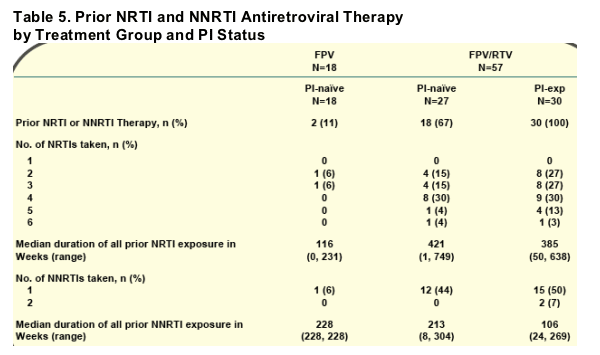
As of the cut-off date for this interim analysis, the majority of subjects had >48 weeks of exposure to study treatment, with a median duration of exposure of 366 days (range 15 to 588 days).
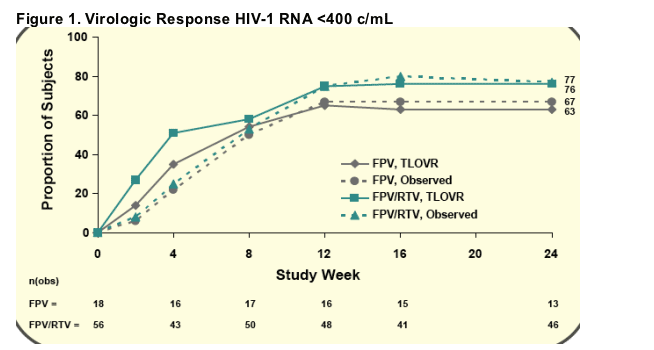
In the ITT(E) TLOVR analysis, the percentage of subjects achieving plasma HIV-1 RNA <400copies/mL at the Week 24 visit was similar between the PI-naive subjects in the FPV (12/18, 67%) and FPV/RTV groups (19/27, 70%) with a
somewhat lower response (17/30, 57%) for the PI-experienced subjects in the FPV/RTV group.
In the ITT(E) TLOVR analysis, the percentage of subjects achieving plasma HIV-1 RNA <50copies/mL at the Week 24 visit was similar between the PI-naive subjects (12/27, 44%) and the PI-experienced subjects (10/30, 33%) in the FPV/RTV groups with a somewhat lower response (4/18, 22%) for the PI-naive subjects in the FPV group.
In the ITT(E) TLOVR analysis by age, the 12 to 18 year old age group had the largest proportion of subjects (79%, 23/29) with HIV-1 RNA levels <400copies/mL at Week 24 compared to the 6 to 11 year old age group (44%, 11/25) and the 2 to 5 year olds in both the FPV (67%, 12/18) and FPV/RTV groups (67%, 2/3).
Differences in response by age groups are at least partially explained by differential baseline ARV resistance by age. A greater proportion of subjects in the 6 to 11year age group harbored virus with primary PRO mutations (47%)
and >3 NRTI mutations (47%) than the 12 to 18 year age group (28% and 36%, respectively). However, of those with primary PRO mutations, none were APV resistance associated (V32I, I47V, I50V, I54L/M, I84V). The NRTI mutations
observed most frequently were the thymidine analog mutations (TAMs) in 23/41 (56%) subjects.
The median CD4+ cell count at baseline was 809 cells/mm3 in the FPV group and 362 cells/mm3 in the FPV/RTV group. At Week 24, the median % CD4+ cell count change from baseline was 4% in the FPV group and 6% in the FPV/RTV
group.
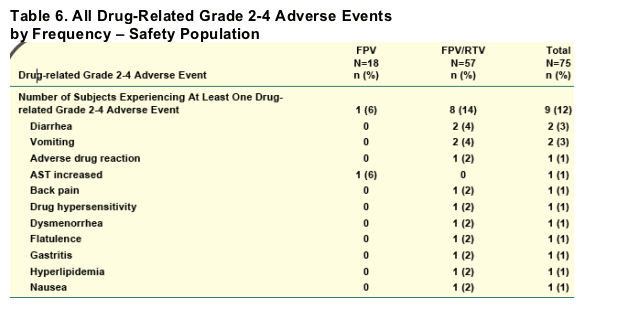
The most common drug-related AEs of any grade that occurred in the FPV/RTV group were gastrointestinal in nature (vomiting, followed by diarrhea). Vomiting was the most common drug-related AE of any grade in the FPV group as
well. However, most episodes of these drug-related gastrointestinal events in both groups were Grade 1 in severity, of short duration (median duration of vomiting, diarrhea and nausea were 1 day, 3 days and 8 days, respectively in the
FPV group, and 1 day 17 days and 8 days, respectively in the FPV/RTV group), and were not treatment-limiting.
Two subjects reported AEs leading to permanent discontinuation of study drug and withdrawal from the study: vomiting (one subject) and adverse drug reaction (one subject).
Nine subjects (12%) experienced at least one Serious Adverse Event (SAE). The only SAE reported in more than one subject was drug hypersensitivity to ABC (8%, 6/75). Two of the SAEs were considered by the investigator to be drugrelated: adverse drug reaction and drug hypersensitivity, both occurring in the same subject. There were no fatal events as of the cut-off date for this report.
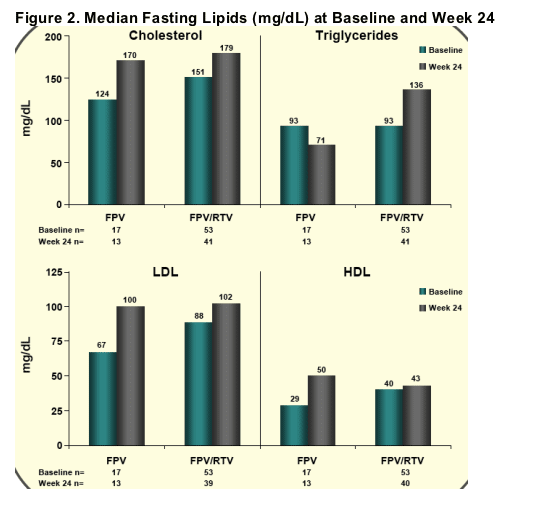
|
| |
|
 |
 |
|
|